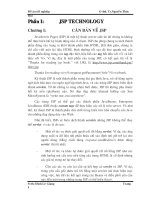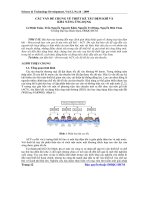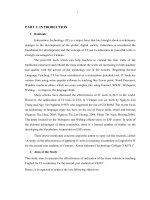Biofloc technology
Bạn đang xem bản rút gọn của tài liệu. Xem và tải ngay bản đầy đủ của tài liệu tại đây (3.93 MB, 42 trang )
Professor Yoram Avnimelech
(Yoram)
Technion, Israel Institute of Technology
Haifa, Israel
Biofloc technology
Important fact to remember
• Fish (shrimp) are fed
with a lot of feed
• About 70-80% of it
remains in the pond,
in the water or the
sediment.
• Ponds contain a high
load of nutrients
What are the outcomes??
• 1. We waste Feed/Money (Quite a lot!)
• 2. Toxic residues (Sulphides, Ammonia
etc) accumulate.
• 3. Fish growth is affected.
• 4. Intensification is limited.
What can we do??
• No Intensification (loose income, not being
able to raise production).
• Use industrial RAS (Recycling Aquaculture systems)
Quite expensive
• Use biofloc technology
• (BFT)
What is BFT?
• 1. We limit water exchange
• 2. Organic residues accumulate
• 3. We mix and aerate.
• 4 Ideal conditions for bacteria
• 5 Bacteria control
water quality.
6. Fish eat bacteria
7. Feed is recycled
How does it work
• Heterotrophic bacteria feed on organic
matter.
• BASICALLY
• C
6
H
12
O
6
+ 6O
2
6 CO
2
+ Energy
• BUT Bacteria are made of protein so they
need nitrogen (We will discuss this later)
• They use the Chemical energy in organic
substrates. Consume oxygen (Though there are
anaerobic bacteria).
• Unlike algae, almost un-limited capacity
Conditions for bacteria
• 1. There is a lot of available food for bacteria.
The pond is loaded with organic residues.
• 2. The pond is fully aerated (needed for proper
fish growth).
• 3. The pond is well mixed (typically 24 hours a
day)
• 4. The number of bacteria in such ponds is
10
6
up to 10
9
Bacteria in one cm
3
!!!!
• The pond becomes a biotechnological
industry – Biofloc Technology
The nitrogen syndrome
• N
• NH
3
• NH
4
• NO
2
• NO
3
• Organic N
• Ammonium is excreted
by fish
• NH3 and NO2 are toxic
The Major problem: Inorganic nitrogen.
Ammonia, NH3 and nitrite, NO2
Are toxic.
Maximal safe NH3 concentration for shrimp is
0.2 mg/l
At neutral pH maximal total NH4 concentration
= ~ 2 mg/l
NH3)/(NH4) ( = Kd/(H+)
The fraction of NH3 rise with increase in pH
Manipulating bacteria
• Normally, there is enough
nitrogen in ponds for new cell
production.
• BUT we can add carbon rich
and protein poor material
(carbo-hydrate, CH), such as
starch or cellulose (flour,
molasses, cassawa etc.
• Then, there is a need for
nitrogen.
• The way to do it: Keep C/N ratio
higher than 10
• The bacteria now take the nitrogen
from the water and control water
quality
Table 6.1: C/N ratios of feed materials
Protein content (%)
C/N
15
21.5
20
16.1
25
12.9
30
10.8
35
9.2
40
8.1
Bacteria have to produce protein. If the substrate is
mostly carbonaceous, they need to take nitrogen from
the water
Changes in TAN concentration in a suspension of pond bottom soil (2% dry soil)
following the addition of glucose (TAN/glucose ratio of 1/20)*
*Avnimelech, 1999.
Inorganic nitrogen control is
possible and predictable.
• EXAMPLES
Fish ponds in Israel
Over wintering of tilapia
Emergency treatment in shrimp ponds in
Thailand
Shrimp ponds in Indonesia, many places
Summary till now:
• 1. We know how to get active microbial system.
• 2. We know how to tell the bacteria to control
water quality.
• 3. This enables to intensify production without
the need to install special system.
• 4. As a by-product, bacteria produce large
amounts of protein (ca 60 and 600 kg/ha per day
for shrimp and tilapia culture).
• CAN WE UTILIZE THIS PROTEIN???.
Can we feed fish or shrimp with
bacteria
• Bacteria are very small.
• Luckily, when we have a dense culture,
• They tend to form bioflocs, containing
bacteria, other organisms and organic
particles.
BIOFLOC Systems
Let us floc
together and
keep company
Courtesy of Dr. Michelle Burford
Each cm3 of floc plug contain 10-
30 mg dry matter
pond
Can we use this microbial activity?
• We will deal with this extensively.
• The microbes degrade the waste, part of it
to CO
2
and about 50% to microbial
biomass.
• We can manipulate the microbial activity
toward the control of nitrogen in the pond.
• The bacteria makes an important part of
the food chain.
• They seem to improve disease protection.
x
4
0
x
x40
x20 x10
x10 x10
200 µm
200 µm 200 µm
F
l
o
Bio flocs are made of bacteria,
protozoa, etc. Typicaly their
diameter is 0.1-2 mm.
Courtesy of Dr Michelle Burford
Mixing and aeration are typical features of
bio-technological industry
Biofloc technology is biotechnology









